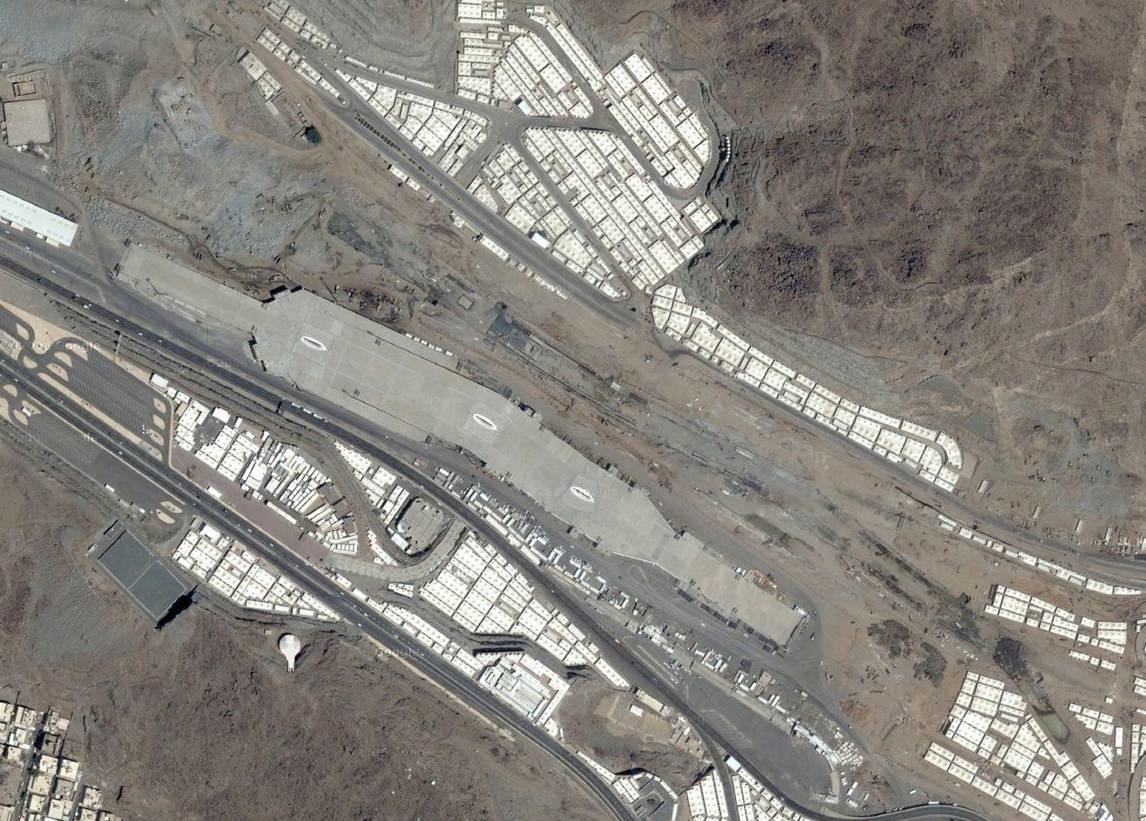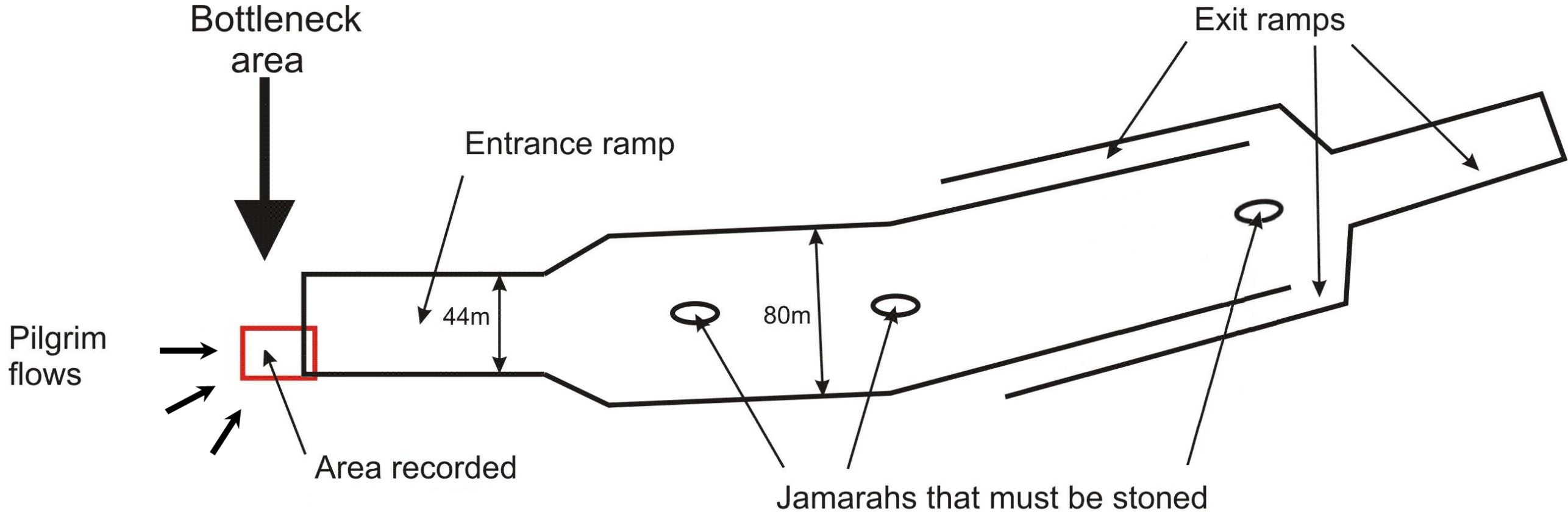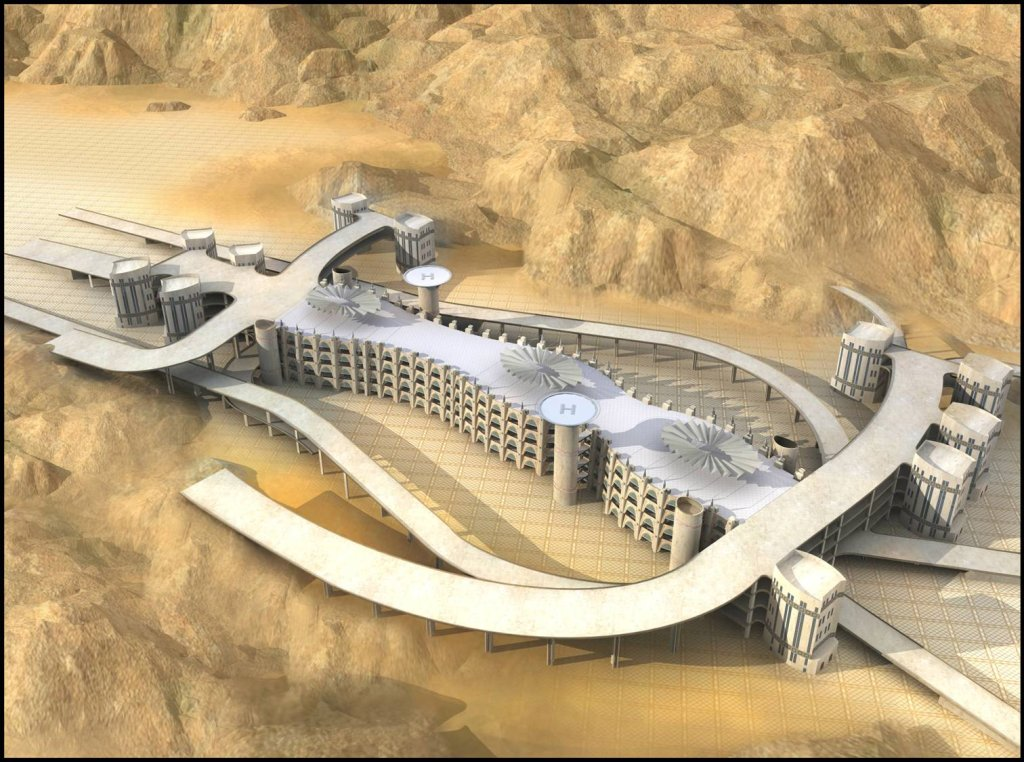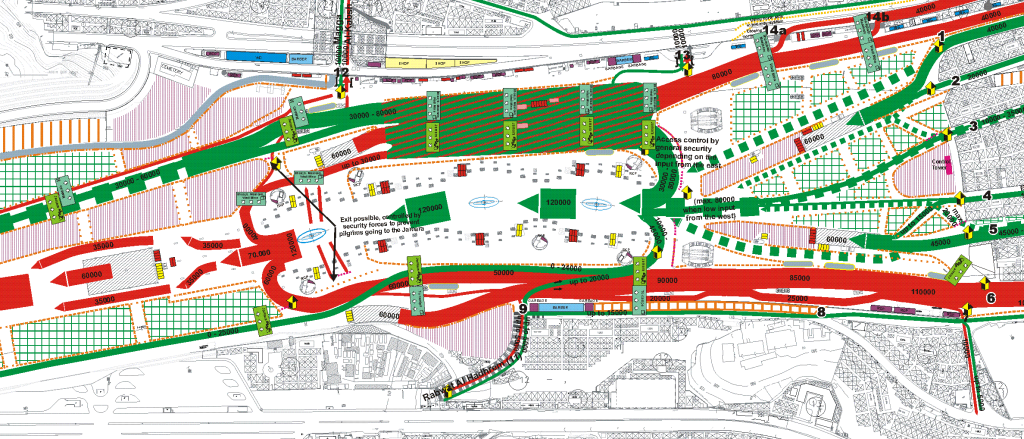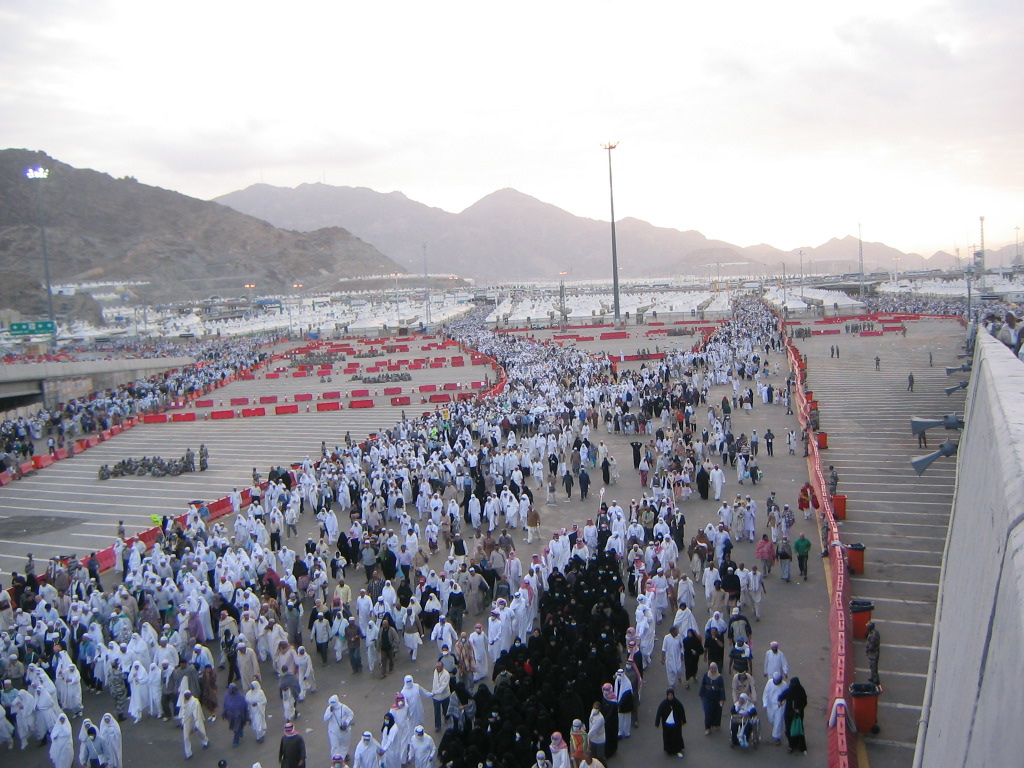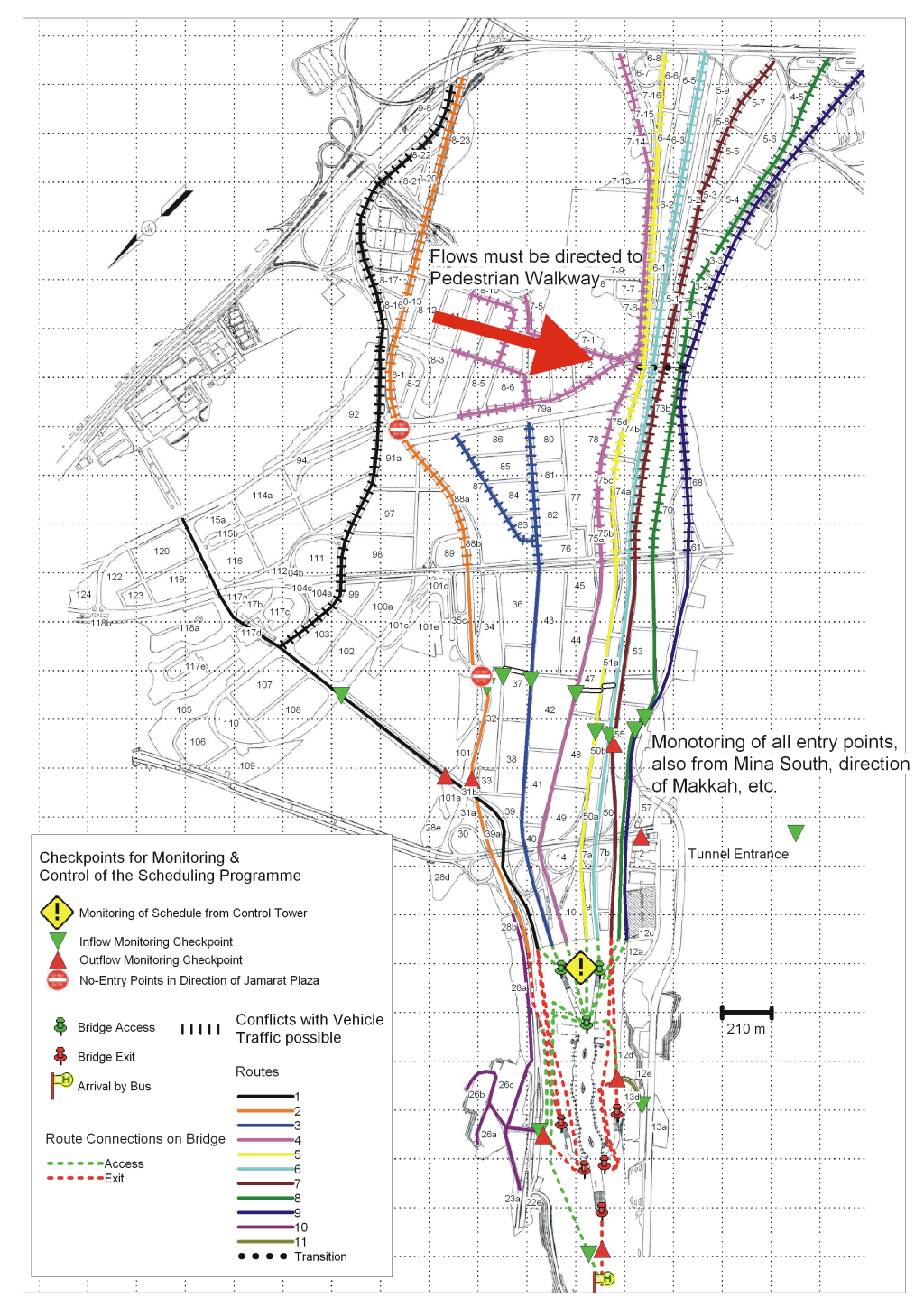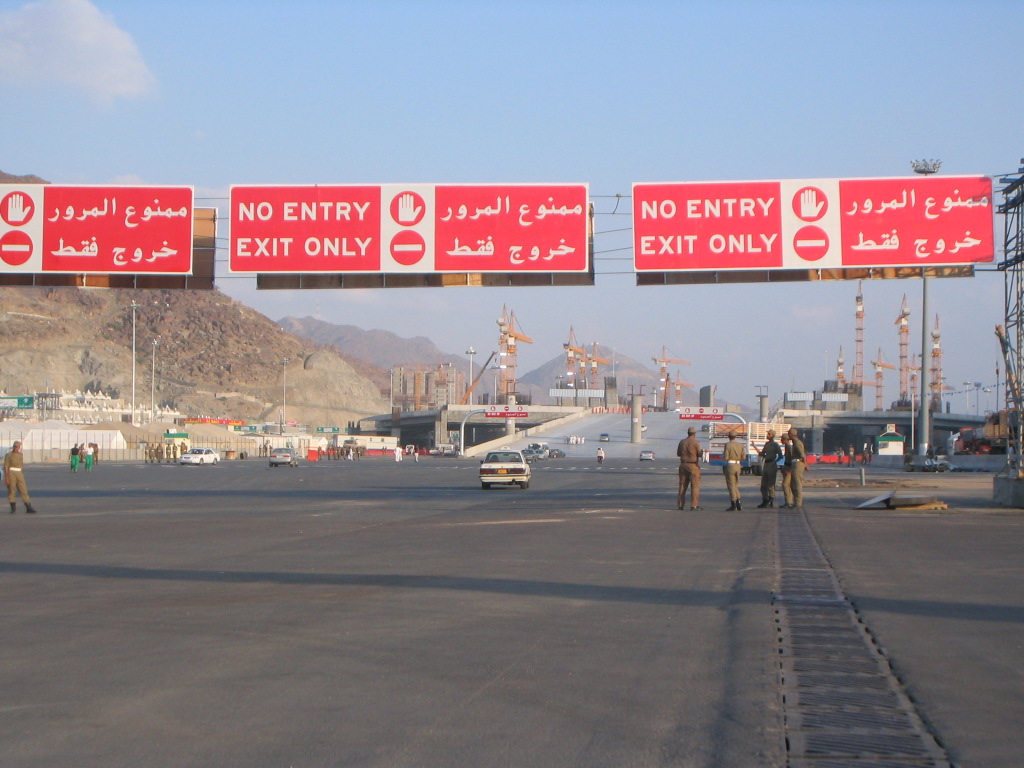The Dynamics of Crowd Disasters: An Empirical Study (Supplementary information)
Published in Physical Review: external page Dynamics of crowd disasters: An empirical study
- D. Helbing, A. Johansson and H. Z. Al-Abideen (2007) The Dynamics of Crowd Disasters: An Empirical Study. Physical Review E 75, 046109.
- Satellite Picture of Mina/Makkah [link missing]
- external page Hajj - The Religious Rituals During the Annual Muslim Pilgrimage
Aerial Photograph of the former Jamarat Bridge (as of January 2006):
Illustration of Pilgrim Flows:
The following sketch illustrates the recorded area at the entrance to the Jamarat bridge and the approximate directions of pilgrim flows. Many other places have been recorded by additional cameras.
Video Clip:
The following video clip shows the transition from laminar to stop-and-go flow. The original video recordings have been accelerated 10 times to display the dynamics more clearly. Morever, the contrast has been increased and the resolution reduced to compress the video sequences.
Legal Notice:
This video clip may be only viewed for scientific purposes. Downloading, copying, distributing, or showing this video requires written permission. Thank you for your understanding. (The video of crowd dynamics should appear after pressing the "I accept" button. In case of any viewing problems, you may have to upgrade your web browser.)
[missing link]
more Videos (same conditions):
- Video analysis highlighting areas of high pressure in the crowd [missing link]
- Video showing how the pressure builds up in front of the Jamarat Bridge [missing link]
- Video showing stop and go waves in the crowd [missing link]
Video Animations of Dense Granular Flows:
H. J. Tillemans: external page 2d shear cell filled with polygons giving "earthquakes"
S. Schöllmann and S. Luding: external page Force network in a 2d rotating shear cell filled with about 3000 circular discs with two different sizes
Some Changes During the Hajj in 1427H:
Our recent insights into the reasons of crowd disasters have led to an extensive data collection and re-organization of the Hajj in 1427H (December 2006).
The following illustration shows how the new Jamarat bridge will look like, when it is finished. The different levels are to serve pilgrims coming from different areas and directions in order to reduce the crowding on the Jamarat plaza. Note that, as of December 2006, the top three levels were still missing, i.e. the construction stage at that time consisted of a ground floor and a first floor (see the two incoming ramps on the right and the central outgoing ramp on the left).
In order to avoid counterflows of pilgrims close to the Jamarat plaza, the following street organization for 1427H (December 2006) was proposed by IVV Engineers, Aachen, in collaboration with us. It was characterized by flexible re-routing possibilities of flows into the Jamarat plaza close to the Jamarat Bridge (see central area). In this way, an over-utilization of one of the ramps or the entry to the ground floor could be avoided. Moreover, balanced inflows allowed for an optimal usage of the capacity of the Jamarat Bridge.
This photograph shows the flexible plaza organization in 1427H in operation:
In order to reach a homogeneous distribution of the registered pilgrims in space and time, a time schedule and route assignment for 1427H was developed by Prof. Haase of the TU Dresden for each camp by means of a detailed optimization program, in collaboration with us and Dr. Erfan Qasimi. The main routes are shown by different colors (routes according to Dr. Erfan Qasimi, on a map provided by Dr. Keith Still). In the years before, all routes could be used in both directions, which caused a mutual obstruction of in- and outflows. In 1427H, routes 2 and 7 became one-way routes back from the Jamarat plaza, while routes 3, 4, 5, and 6 became one-way routes to the Jamarat Bridge. The capacity of the in- and outflows were carefully adjusted to the capacity of the Jamarat Bridge. Moreover, the flows were controlled by access points and monitored by checkpoints and video cameras. A postprocessing of the video recordings allowed the security forces to determine the number of pilgrims passing certain cross sections in real time. Note that a large number of pilgrims from the Northern camps had to be directed to the South in order to avoid an overutilization in the North.
This photograph shows the no-entry signs at the one-way routes.
As the construction stage of the Jamarat Bridge progresses, the organizational concept will have to be changed and adjusted. This will be an interesting task for international crowd experts, while the authors of this paper and supplementary web page will reach out for new challenges... By the way, while the above and dozens of other organizational changes were suggested by international and Saudiarabian experts, the full responsibility for the implementation was with the corresponding Saudiarabian authorities. Therefore, we would like to congratulate to their great efforts and success in 1427H.
Who Did What in Preparation for 1427H (to clarify facts after some inaccurate press reports):
Dr. Keith Still of Crowd Dynamics Ltd. proposed several improvements in the design of the New Jamarat Bridge based on extensive crowd simulations, which go back to the year 2001. In particular, he proposed the dimensions of the new elliptical Jamarah design intended to increase the stoning capacity and to decrease the likelihood of crushing accidents. Dr. Still also made many useful recommendations regarding crowd management and control. Further information on his activities can be found on the webpages of Crowd Dynamics Ltd. Note that Prof. Helbing was NOT involved in any activities concerning the bridge design.
Dr. Hubert Klüpfel and his colleagues of TraffGo GmbH have approved the safety of the New Jamarat Bridge and performed simulations of evacuation scenarios based on a cellular automata pedestrian model. See external page The simulation of crowd dynamics at very large events
Dr. Erfan Qasimi developed a computer program based on the commercial software GAMS in order to optimize the scheduling program. Apart from a time schedule for each pilgrim group, his software also proposed one of several alternative routes to the Jamarat Bridge and back. In the past, however, a simpler scheduling program had been used.
Dr. Dirk Serwill of IVV Engineers developed an improved organization of the Jamarat plaza and the surrounding that complied with previous expert proposals, including the separation of different flow directions, the separation of pilgrim from vehicle flows, and the reservation of space for emergency operations. He also developed operational plans for cases of incidents.
The new one-way organization of the streets close to the Jamarat plaza posed the problem of how to bring pilgrims to the Jamarat Bridge who had used routes 2 or 7 in previous years. Prof. Dr. Knut Haase of TU Dresden, in collaboration with Dr. Erfan Qasimi, developed a scheduling program distinguishing routes to and from the Jamarat Bridge. He also considered different bottlenecks such as the various entrances to the Jamarat Bridge, and he took into account the movement times to the Jamarat Bridge. The result was a good balance of pilgrim flows in space and time, considering the available data and boundary conditions.
Prof. Bernhard Schlag of TU Dresden and his collaborators developed an improved awareness program for pilgrims.
Anders Johansson of TU Dresden developed a software to count pilgrims and evaluate the spatio-temporal dynamics in the crowd. This was the precondition for the analysis of the dynamics of the crowd disaster in 1426H.
Prof. Dirk Helbing of TU Dresden noticed that the shock waves in dense crowds had features of turbulence and earthquakes. He also recognized the transitions from laminar to stop-and-go and turbulent flows and identified the variables controlling these transitions. Furthermore, has has helped to put the international expert team together. Two of his PhD students are Muslims.
Dr. Habib Al Abideen, together with Salim Al Bosta, have been involved in most activities as well. They have, in fact, managed the whole project. In particular, they have provided the video recordings and pushed many of the research activities.
Note that external expert recommendations are never implemented completely or exactly. It's a matter of (sometimes last-minute) political decisions, which recommendations are given what priority, and which are dropped. In the end, it is always Saudi expert teams, who make independent recommendations and the final implementation. External experts have no influence on this. For this reason, international experts do not have and cannot accept responsibility for the outcome.
Also note that the preparations for the Hajj in 1428H (December 2007) must differ from the ones for 1427H, as the construction stage of the Jamarat Bridge and other facts have changed in the meantime. The team preparing for the Hajj in 1428H and later years has changed as well. Note that we explicitly warn from transferring solutions from one place to another without considering the particularities.
Some Additional References:
- Helbing, D., Johansson, A., Mathiesen, J., Jensen M.H., and Hansen A. (2006) external page Analytical approach to continuous and intermittent bottleneck flows. Physical Review Letters 97, 168001.
- Behannon, J., Directing the Herd: Crowds and The Science of Evacuation Science 310,219-220 (2005).
- Transportation Research Board, Highway Capacity Manual (Transportation Research Board, Washington, D.C., 1985), Special Report 209, Chapter 13: Pedestrians.
- Glanville, W. H., Research on Road Traffic, Chap. 12: Pedestrians (Her Majesty's Stationery Office, London, 1965).
- Daamen, W. and Hoogendoorn, S. P., Experimental Research on Pedestrian Walking Behavior, 82nd Annual Meeting at the Transportation Research Board, proceedings on CD-Rom (2003).
- Oeding, D., Verkehrsbelastung und Dimensionierung von Gehwegen und anderen Anlagen des Fußgängerverkehrs, Straßenbau und Straßenverkehrstechnik 22 (1963).
- OFlaherty, C. A. and Parkinson, M. H., Movement on a city centre footway, Traffic Engineering & Control 13, 434-438 (1972).
- Older, S. J., Movement of pedestrians on footways in shopping streets, Traffic Engineering & Control 10, 160-163 (1969).
- Lam, W. H. K. and Cheung, C.-Y., Pedestrian speed/flow relationships for walking facilities in Hong Kong, J. Transp. Engineering 126(4), 343-349 (July/August 2000).
- Togawa, K., Study on Fire Escapes Basing on the Observation of Multitude Currents Building Research Institute, Ministry of Construction, Tokyo, 1955.
- Lee, R. S. C. and Hughes, R. L. , Prediction of human crowd pressures, Accident Analysis and Prevention 38, 712-722 (2006).
- Pheasant, S. T., Bodyspace: Anthropometry, Ergonomics, and the Design of Work (Taylor and Francis, London, 1998).
- Teknomo, K., Microscopic Pedestrian Flow Characteristics: Development of an Image Processing Data Collection and Simulation Model, Ph.D. Dissertation, Tohoku University Japan, Sendai, (2002).
- Helbing, D., Farkas, I. J., Molnar, P. and Vicsek, T., Simulation of pedestrian crowds in normal and evacuation situations. Pages 21-58 in: M. Schreckenberg and S. D. Sharma (eds.) Pedestrian and Evacuation Dynamics (Springer, Berlin, 2002), and references in this review.
- Government of Canada, Emergency preparedness guidelines for mass, crowd-intensive events [missing link]
- external page Musterversammlungsstättenverordnung 2005
- Health and Safety Executive, The Event Safety Guide (HSE Books, Norwich, GB, 1999).
- Health and Safety Executive, Managing Crowds Safely (HSE Books, Norwich, GB, 2000).
- The Scottish Office, Guide to Safety at Sports Grounds (The Stationery Office, Norwich, GB, 4th edition, 1997).
- Health and Safety Executive, Steps to Risk Assessment. Case Studies (HSE Books, Norwich, GB, 1998).
- Independent Street Arts Network, Safety Guidance for Street Arts, Carnival, Processions, and Large-Scale Performances (Independent Street Arts Network, London, 2004).
Some Interesting Links:
- Keith Still: external page Crowd Dynamics (contains a large collection of interesting materials)
- Hans Herrmann: external page Video Animations of Granular Flows
- Serge Hoogendoorn: Pedestrian Experiments and Simulations [missing link]
- Andreas Schadschneider: external page Traffic, Pedestrians, and Ants
- Victor Blue: Cellular Automata Simulation of Pedestrians [missing link]
- Andy Adamatzky: external page Dynamics of Crowd Minds
- Illes Farkas: external page Simulation of Crowd Panic
- RiMEA: external page Richtlinie für Mikroskopische Entfluchtungs-Analysen
Such a list is naturally always incomplete. Please inform us of any links you would like us to add.
